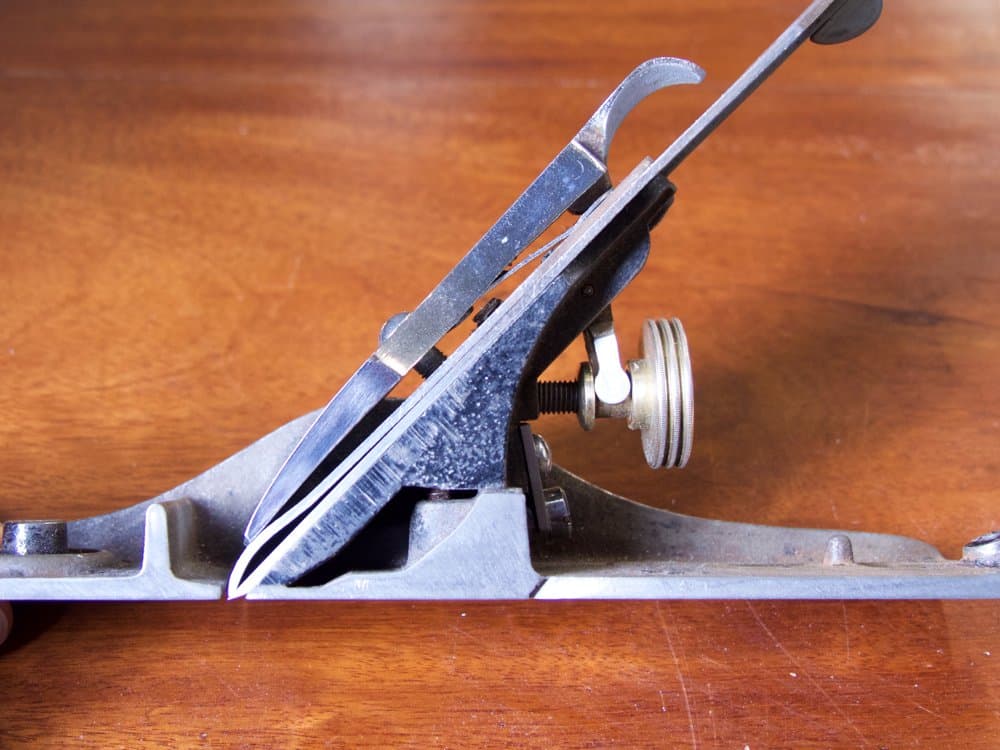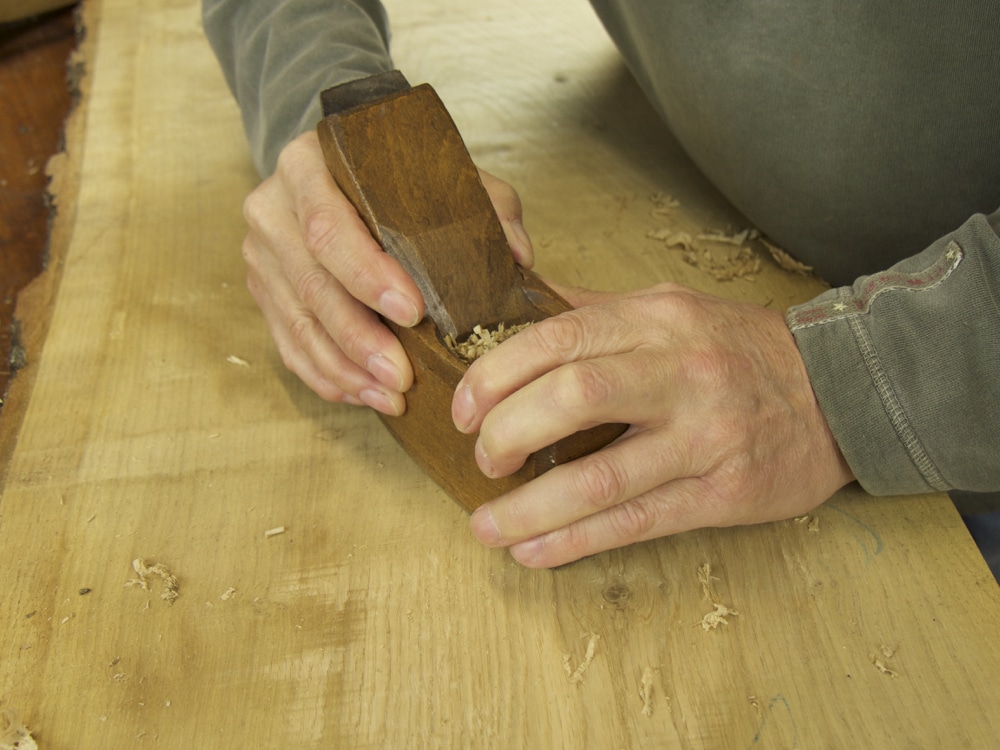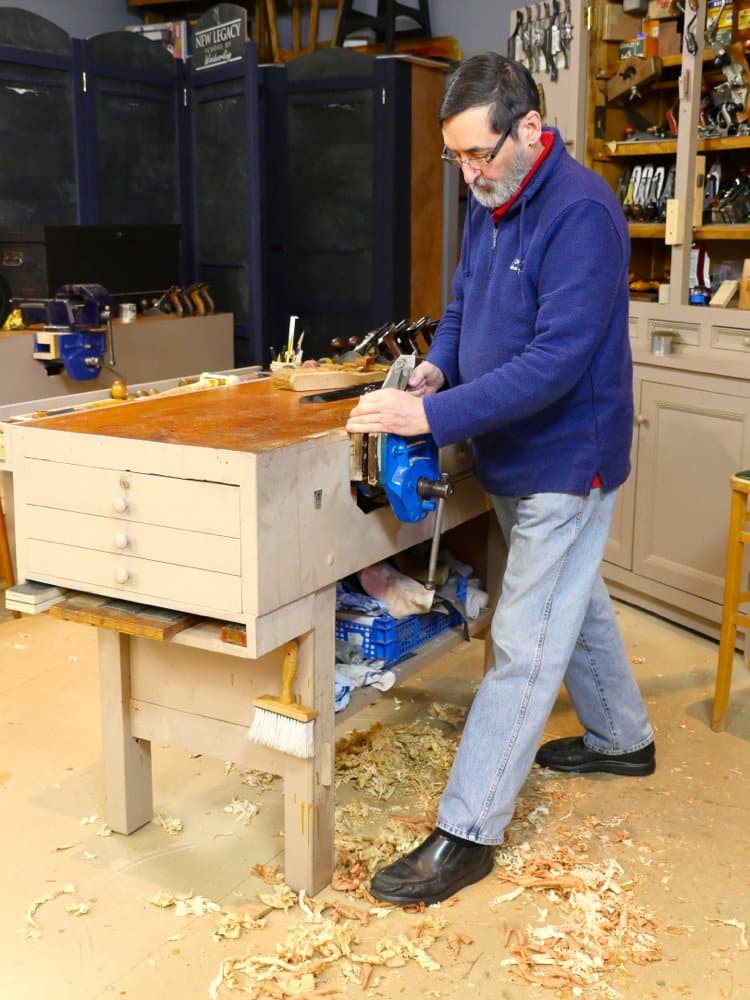Sharpening is a Response
I think that it is a true thing that we should make a saying of; most of us wait until the tool won’t cut well before we decide to sharpen our tools. Pushing dulled tools to the limit is not just pushing the tool to its limit but also the wood and our bodies. Woodworking is not resistance training as in gym work, rock climbing or mountaineering, or any other sports training to gain strength and stamina reliant on muscle and strategy, it’s a response to conditions influencing the work in hand and especially is this so with regards to the tool’s sharpness. Planing is a progressive task and stroke on stroke dulls the cutting edge we rely on. When do you sharpen up? As a boy, I would hear George say, “Sharpen up, Paul!” There is no George now and neither do I want to hear his voice admonishing me. There comes a point with maturity where you should own tasks like sharpening, cleaning, maintenance and sweeping and respond to the higher demands of fine woodworking. I have learned more about hand tools in the last ten years than in the previous 45 prior to now. I want to hear my inner voice and respond to it willingly, not a big stick or worse still a resulting failure that tears at the materials or damages the tool. Mostly dull tools result in the use of brute forces. Not at all the way to progress good woodworking.

I have written on the missing ingredient even well-known advocates for high, over-the-bench, upper-body pressure on low-down workbenches seem less inclined to talk about. I’m never sure if they just followed a pattern established by say French 17th century makers established for themselves or whether they actually worked it out for themselves. I have seen people well over six feet planing on what seemed to be almost knee-high workbenches that made me think, ‘Something’s wrong with this picture.’ You must consider that today’s average French person is 5’7″ whereas the English is 5’9″ and the USA average is a little lower, somewhere between France and the UK. Of course, this doesn’t help too much because there are heights that affect averages throughout.

Perhaps some listen and perhaps not. The simplicity of plane work in my view and from research, our questionnaires and then 6,500 students in hands-on, at the bench classes, etc is this: It is a fact that the optimum height is the one you ultimately decide on for yourself. I have posted many blogs on this for you to make an educated decision on this.

Fact is, you will find that with using a sharp plane the plane pulls itself downwards to the surface of the wood as it’s pushed forward onto and into the wood. With a dull one, it simply slips and slides over the top of the surface like an ice skater and any hard forcing down achieves very little. By this simple fact, top pressure is applied to the top, flat face of the blade, as you push forward, thus the plane blade in the wood, pulls the whole plane down to the wood as the stroke progresses with each forward stroke you take. This then is the reality of natural physics in action. If you can grasp this then you will indeed see the significance of regular and precise sharpening as a response to you sensing the plane starting to glide over the wood surface rather than onto it as an efficient cutter does. If you take nothing away from this article other than this reality I have won.

I argue too about some who say heavy planes being the way forward. I think a heavy plane has a place but not really for the day to day benchwork planing. Most advocates I’ve known sell them. I might have thought differently at one time but I am more convinced today than ever that any correctly sharpened and set lighter-weights beat heavyweights hands down.

Why do I say that? Well, the former masters of old would not take even the lightweight Stanly planes fo at least half a century when they first came out, and it was not just stubborn refusal of accepting progress. In the wood-bodied, pre-cast-metal plane days, the planes were half the weight of even the basic Stanley #4s. Even the longer jointer and tri-planes were lighter, much, much lighter than the steel interlopers. But it wasn’t just lightness either, these wood-on-wood planes would glide over the wood being planed as if frictionless. Not the same with the basic Stanley and so much less so with the brutes of heavyweights some seem wont to promote. Again, those crafting artisans by the hundreds of thousands across and throughout Europe knew it was the sharpness that pulled the plane to task and sharpness was neglected only by the lazy.

As a practicing artisan, I learned early on to trust my intuition. Sharpening is a constant. Bench height is worked out by you with the help of me. By responding to feel we engage unquestioningly in sharpening. It’s a response not an option for us.


Paul, i own some nice Ashley and Iles chisels and Stanley Planes, but always strugle to keep them Sharp. I See All Kinds of sharpening Tools but just don’t know what to but. Can you advise me/us?
Regard from Holland
Jan Willem
Jan Willem, Paul uses diamant plates. And a strop. It works for me too.
Bert, the Netherlands.
As Bert says, diamond plates and strop, definitely. Paul has very instructive videos on this, from making the plate holder and the strop, to sharpening free hand, easily and effectively, without becoming obsessed. A couple of minutes and you can plane everything.
Pay attention not to go over the edge of the blade on the pull stroke during sharpening or stropping too, because it will round the edge and take out the sharpness.
Sand paper on glass works too, but the whole process is not as effective.
I find that sharpening in itself is a great source of satisfaction. Once the initial flattening has been carried out, it’s only a matter of moment to bring the plane or chisel back to that wonderful state whereby they simply work – well.
The singing of a sharp plane, or the ease with which a sharp chisel cuts, utterly satisfying.
I have owned a “lightweight” Millers Falls plane since childhood and because I thought heavier was better bought the same size plane that was heavier. I kept going back to the lighter plane when working so I gave the new heavier plane to my son after using it for a year. He returned it to me after awhile and on his own bought a used plane that was….you guessed it, lighter.
Now it’s a “high end” plane ( read expensive) and built very well so now I just use it for those last few finish passes and keep it super sharp for that purpose. I keep it as a reminder that more expensive doesn’t mean better.
The Stanley no 4 plane ((made in England) is my choice every day. It’s like an extension of your right hand. The design is fool proof and sharpening is a joy. I would say it’s the most important tool in my workshop and would be lost without it. In fact I have a couple of them on hand both sharpened an ready to go at any time
I have aways wanted to pose the philosophical question “When do you sharpen?” and I suspect the retort would be “When its dull”. But I think that is difficult to know, because as you use the tool it slowly looses it’s sharpness and you adjust not realizing how dull it is. These last two articles of yours begin to answer my quandary and you are correct, I (or we) don’t sharpen nearly frequently enough. It is just hard I think to no when and thus routine sharpening is required.
WOW! This post and picture of the cutaway plane really gave me a revelation as to what is happening. So the sole of the plane isn’t “guiding” the iron, but rather keeping the iron from burying itself deeper into the wood, hence why true flatness isn’t important. Kind of like a stick on the end of a plumb bob keeping the plumb bob from pulling itself to the ground. It also reminds me of in the workout world, one thing that made squats “click” was when someone told me “don’t try to push yourself and the weight up, instead try to push your heels through the floor!” This shift in mindset made me truly understand , just like this post did for how planes actually work. Thanks!
True flatnes is important
That’s an odd statement. In most cases, in sharpening, it’s not that important and in many cases, it’s not important at all. Flatness is just something to shoot for but rarely is it the critical thing most people are told to do. Oh, and in our realms there is, of course, no such thing as true flatness.
A few years ago I was searching on internet:
– what workbench height would be recommended by health and safety agencies (why reinvent the wheel?);
– what was the average height when it was published; and
– what body caracteristic would correspond to that height.
The height recommended by Paul Sellers was the lower limit for what was recommended for “light work”; which is consistent with using hand tools for joinery, smoothing and scraping, the rough work being made with machines.
This 38” height for an average man corresponds approximately to the addition of the anterior superior iliac spine height and the shoe heel height.
google “anterior superior iliac spine” and see the pictures.
Whatever your personal height, put your shoes on and measure where it is for you.
I am 1.73 m (~5’8″) and 38″ is good for me
Now I am not a doctor but this measurement is at least related to where your body is articulated which is not the case for any part of your hand or arm.
Sylvain
My grandfather had been a Cabinet Maker back in the 40’s to the 60’s when he retired and I have all of his tools, none of which are big bulky types of planes, almost all of the are light Stanley planes. Since I refuse to use any of the “Family Heirlooms” in my wood working, I have instead attempted to copy his choice of tools by buying almost exactly what he had. At the end of the day, I’ll offer it’s a simple case of using the proper tool for the job and most importantly, taking care of your tools, treating them like finely tuned instruments. The concept of sharpening up before you begin work is flawlessly logical as is adjusting them for whatever task is at hand before beginning the task itself, since I was taught as a Machinist about “Measuring twice and cutting once”, likewise with the idea of 5 days of hard planning leaving a result of 1 day of easy work.
I have followed your advice Paul from day one of trying to becoming a lifestyle woodworker. You have not let me down once. I shall continue on the same path as the joy and changes made in my life have been so good.
Thanks Paul
Glenn
Aloha Paul,
For me, when a plane’s edge has dulled a bit, it’s the lack of the ‘sing’ of the blade across the wood that alerts me to resharpen. A dull plane is more effort also to work with. In a ‘modern workshop’ with so many power tools running, you are robbed of the simple joy of slicing your way to the just-right finish of your piece. The ‘sing’ across the piece helps you with knowing the grain direction, curl of the grain or bird’s eye, alerts you to change the type of tool in use[use a scraper to prevent deep tear-out]and such. These are some labor-saving facts of hand tools working over power tools.
Hello
I think the most tell take signs of when a plane is dull and is ready for sharpening is the wood shavings that are produced. In my humble opinion clean crisp shaving is a sign of a sharp edge.
I think it’s a long time before then.
I’ve always viewed sharpening as an endless pursuit… I’ve tried every new technique, wiz-bang gadget, and abrasive to further my edge… initially with knives, then woodworking tools. Couple of years ago I began freehand sharpening my kitchen knives, then my pocket knives. I could fill a truck with all the jigs, fixtures, and guides I’ve used for just knives…now collecting dust. I thought I had a solid system for planes and chisels; chuck in a guide, progress through the grits, bevel/micro. After using Paul’s approach, I realized this is essentially the same process I use for knives; thin, hone, polish… done. Creates a keen, strong edge that’s quickly repeatable. I’m now reestablishing a new edge on a couple of tools each session in the shop. I still tune the edges of the tools I’ll use each day, but now I resharpen much more often, especially chisels (used to be more time consuming than planes)… enjoying sharpening and enjoying the results even more. Thanks Paul
There was a man with a dull crosscut saw trying to cut down a tree. He was working very hard pulling and pushing the saw while perspiring profusely in the hot sun. A passer by recommended he stop to sharpen his saw. The man responded “I haven’t the time I must get this tree cut down”.
Sharpening/stropping gives my time to think. I like to make time to think, often.
When I’ve used plane irons or chisels I leave them out on my bench. They’re touched up next time.
Hi Paul, I have found in life generally that if it feels right and you have confidence in it then it is right. My workbench is 37 inches tall and the plane I am most comfortable with is a no6, daft I know but there it is. Also I have ridiculous hands that shake ( essential benign tremor) I have had it all my life so you learn to adapt but this means that free hand sharpening is really difficult and a jig is the safest and predictable option. I gave up using power tools for that reason, as you so wisely said handsaws stop cutting when they hit bone. Anyway thanks Paul for your tutelage and please keep up the good work. Regards Jim.
I decided to buy a group of chisels on ebay (one at a time ) made by the most famous Sheffield makers. Ward , Sorby , Marples (old with wooden handles ) Tyzack , Woodcock , Mawhood , and a chunky Mathieson from Glasgow
Some needed attention to flatten the backs. They must have been scraping rust off an old steam engine . I discovered that using an upturned floor belt sander was working well —-apart from the end of the blade. That last 1/4 inch was not being flattened , but gently curved up. The cause was the belt connection was thicker —-so every rotation forced the blade end to drop down to the lower level again . I used a small diamond file to clear the abrasive off the join and an inch after the join. Now the chisel backs come out really flat. I sharpened a number of chisels in rotation so none were allowed to get more than warm . I only used the No 3 speed on the dial .Almost no sparks at all .
It saved a lot of work .Follow up with the recommended polish .
A coarse wood belt is just as good as a fancy blue one for that job .
Not sure everyone has a floor sander though.
I bought a tiny little Chinese style plane . Back to front with a handle sticking out both sides , wooden plane —-out of curiosity. That was remarkably sharp when it arrived . Then I bought the longest plane they sell .If you enjoy the Sound of a well tuned plane you should get one of these for the experience. They cut like a dream and the whispery ,whistly , sound is an absolute joy .
My floor sander is quite a small portable thing .Made by JCB. I have a wood block floor in the hallway and a large hired sander would easily make dents . The blocks were never levelled originally when laid down with bitumen. I thought the sander design was terrible for floors as the belt alignment argues with the handle positions . But by using both hands and resting my body on a padded stool I found a balanced position to work on these blocks . The control and evenness is excellent .The tiny bag for the dust seems to work very well .
A fire safety note is to clean out any wood dust before using it on metal causing sparks .
This Is the reason why I’m so focused on training my freehand sharpening.
A fresh sharp edge makes the work so easy, and It avoids damages to the piece.
So It Is always a good idea to sharpen.
With food it’s the same. Try to slice a tomato with a dull edge.. It is nearly impossible.